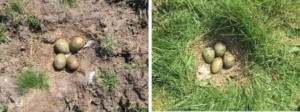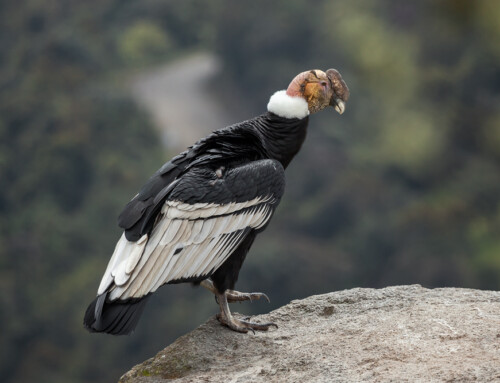LINKED PAPER
Placement, survival and predator identity of Eurasian Curlew Numenius arquata nests on lowland grass-heath. Zielonka, N.B., Hawkes, R., Jones, H., Burnside, R. & Dolman, P.M. 2019. Bird Study. DOI: 10.1080/00063657.2020.1725421. VIEW
Why studying curlews is important
You may be familiar with the sight of 1000s of European Curlews Numenius arquata (henceforth “curlew”), filling mudflats on wintery days so it may be surprising to hear that the curlew is the UK’s top conservation priority (Brown et al., 2015; to explore read the WaderTales blog “Is the Curlew really ‘Near-Threatened’?” by Graham Appleton, 2015). The unmistakable call of the curlew was once a much-awaited sign of the British spring, but the loss of their breeding habitat and the increasing abundance of nest predators have resulted in the numbers of UK breeding pairs declining by up to 82% over the past three decades (Hayhow et al., 2017). Now, the curlew is Red Listed and classified nationally as Threatened (Global IUCN Near-Threatened; BirdLife International 2017).
Across the UK, the reason for curlew decline is simple – not enough chicks fledge each year. Curlews are grassland breeders, preferring tall swards that provide cover for nests, and a safe refuge for chicks. Unfortunately, as farming intensifies, with more frequent harvests, pesticides and heavy-machinery use, this habitat is becoming a thing of the past (Franks et al. 2017). These changes have coincided with increases in generalist predator numbers, namely Red Foxes Vulpes vulpes and Carrion Crows Corvus corone, which thrive across agricultural landscapes that provide them with easy prey all year round (Roos et al. 2018).
With the demand for food growing and unlikely to decrease in the foreseeable future, the answer to securing a future of UK curlew is far from simple. Research within UK uplands is informing trial conservation interventions, through the creation of pools, controlled moorland cutting (Fisher & Walker 2015) and predator control (Fletcher et al., 2010), whilst lowland curlew populations remain largely unstudied and vulnerable to extinction.
Lowland curlews largely occupy dry grasslands and heathland, where physical ground-disturbance is increasingly advocated as a land management intervention for other rare, scarce and threatened species, such as Woodlark Lullula arborea (to find out more read Hawkes et al. 2019a). The impact of this management on curlew nest placement or breeding success remains unknown, thus, to inform conservation interventions for the lowland curlew, we studied nest placement, nest survival and nest predator identity within the UK’s largest lowland curlew population in Breckland (at least 100 breeding pairs but likely more, H. Ewing pers. comm.), across two grass-heath sites (3,700ha), which vary in predator density and management, and where landscape has been diversified with physical ground-disturbance prior to this study.
Results – Curlews’ preference for disturbed soil and unjust nest fate
Across 2017 and 2018 breeding seasons, we monitored 46 curlew nests and were surprised to find 49% of nests on physically-disturbed ground (which only occupied 8.2% of monitored grassland). This indicated a preference for disturbed ground as nesting habitat, and in fact, curlews were five- to six-times more likely to place their nests on the plots, relative to their availability across the landscape. Whilst more research is required to explain this preference, we suggest that curlews may have placed nests on disturbed ground to allow greater vigilance for predators (as disturbed grassland is characteristically bare and short in comparison to uncultivated grassland, Figure 1) or to take advantage of high prey abundances (Hawkes et al. 2019a-b).

Figure 1 Eurasian Curlew Numenius arquata nest on physically-disturbed ground plot (left) and on grassland (right) in Breckland, UK. © Natalia Zielonka
Our monitoring has confirmed very low nest survival, which contributed to unsustainably low breeding productivity of 0.16 ± 0.01 SE fledged chicks per nesting attempt (0.48-0.62 is the level of breeding productivity required to sustain curlew populations; Grant et al. 1999). Nest predation was overwhelmingly responsible for nest failure but more importantly, the survival of nests on ground-disturbed plots was not different to nests placed on grassland.
Though the comparison is semi-anecdotal as we only monitored two sites, we found that nest survival was significantly higher at the fenced site, where predators were more intensively controlled (nest hatching probability at Brettenham Heath was 0.70 ± 0.18 SE, versus 0.16 ± 0.06 at STANTA). At our unfenced site with higher predator density, STANTA, 29/33 nests were lost to predation. Across the sites, predation was disproportionally higher at night (17/23 predation events for which timing was known; Figure 2), which is characteristic of mammalian predators.

Figure 2 Date and time of 23 Eurasian Curlew Numenius arquata nest predation events, where light grey shading indicates crepuscular (between dawn and sunrise, and between sunset and dusk) and darker grey indicates nocturnal (between dusk and dawn) periods. Symbols represent different predator species: crosses denote cases where predator was unknown, squares denote Red Fox Vulpes vulpes and triangle denote Sheep Ovis aries
Having identified the initial patterns in 2017, we monitored a subset of nests with cameras at STANTA in 2018. Nest cameras recorded five predation events, four of which were by foxes (one diurnal and three nocturnal; Figure 2 and 3) and one by a sheep (head to the accompanying website to view footage: https://eurasiancurlewnestproductivity.simplesite.com/). This confirmed that scrapes of nests predated by foxes were undisturbed and without any shell remains, which was consistent with all other nocturnally predated nests in our study (and supported findings of other studies e.g. Koshkin et al. 2016), which strongly implicated that foxes were the primary nest predator of curlews in this landscape.

Figure 3 Predation of Eurasian Curlew Numenius arquata eggs by a Red Fox Vulpes vulpes. The incubating parent left the nest at 00:18, likely as it spotted the oncoming predator (image A), which then took all four eggs, one by one, between 0.26-00:30 (B-E). The parent returned in the early hours of the next morning to discover an empty nest (F) © Natalia Zielonka
Conservation implications – what can we do?
We have taken advantage of a unique opportunity to study the impact of experimental management on nesting curlew to show that physical ground-disturbance, which is advocated as a conservation measure within lowland dry grasslands for many rare, scarce and threatened species (Fuller et al., 2017; Hawkes et al., 2019a-b), also provides suitable curlew habitat. The preference for ground-disturbed plots could be exploited to attract nesting curlew to areas safe from predators (e.g. fenced areas or where predator management is implemented).
Addressing the unsustainably high rates of nest predation remains the key priority and experimental tests, examining the efficacy of different anti-predator options as a way of improving breeding success within lowland grasslands are urgently required. Luckily, the monitoring of this curlew population is being continued by Harry Ewing (@Ewing_birds), who is a 2nd year PhD student at UEA working to gain in-depth understanding of the breeding and habitat requirements of lowland curlews to develop, implement and trial various conservation strategies. Keep your eyes peeled for updates from the Breckland curlew population!
References
BirdLife International 2017. Numenius arquata. The IUCN Red List of Threatened Species 2017. Available at: https://datazone.birdlife.org/species/factsheet/eurasian-curlew-numenius-arquata (Accessed 30 June 2018). VIEW
Brown, D.J., Wilson, J.D., Douglas, D.J.T., Thompson, P.S., Foster, S., McCulloch, N., Phillips, J., Stroud, D., Whitehead, S., Crockford, N. & Sheldon, R. 2015. The Eurasian Curlew – the most pressing bird conservation priority in the UK? British Birds 108: 660–668. VIEW
Fisher, G. & Walker, M. 2015. Habitat restoration for Curlew Numenius arquata at the Lake Vyrnwy reserve, Wales. Conservation Evidence 12: 48–52. VIEW
Fletcher, K., Aebischer, N.J., Baines, D., Foster, R. & Hoodless, A.N. 2010. Changes in breeding success and abundance of ground-nesting moorland birds in relation to the experimental deployment of legal predator control. J. Appl. Ecol. 47: 263–272. VIEW
Franks, S.E., Douglas, D.J.T., Gillings, S. & Pearce-Higgins, J.W. 2017. Environmental correlates of breeding abundance and population change of eurasian curlew Numenius arquata in Britain. Bird Study 64: 393–409. VIEW
Fuller, R.J., Williamson, T., Barnes, G. & Dolman, P.M. 2017. Human activities and biodiversity opportunities in pre-industrial cultural landscapes: relevance to conservation. J. Appl. Ecol. 54: 459-469. VIEW
Grant, M.C., Orsman, C., Easton, J., Lodge, C., Smith, M., Thompson, G., Rodwell, S. & Moore, N. 1999. Breeding success and causes of breeding failure of curlew Numenius arquata in Northern Ireland. J. Appl. Ecol. 36: 59–74. VIEW
Hawkes, R.W., Smart, J., Brown, A., Jones, H. & Dolman, P.M. 2019a. Experimental evidence that ground-disturbance benefits woodlark Lullula arborea. Ibis 161: 447–452. VIEW
Hawkes, R.W., Smart, J., Brown, A., Jones, H., Lane, S., Wells, D. & Dolman, P.M. 2019b. Multi-taxa consequences of management for an avian umbrella species. Biol. Conserv. 236: 192–201. VIEW
Hayhow, D.B., Ausden, M., Bradbury, R.B., Burnell, D., Copeland, A.I., Crick, H.Q.P., Eaton, M.A., Frost, T., Grice, P.V., Hall, C., Harris, S.J., Morecroft, M.D., Noble, D.G., Pearce-Higgins, J.W., Watts O. & Williams, J.M. 2017. The State of the UK’s birds 2017. The RSPB, BTO, WWT, DAERA, JNCC, NE and NRW, Sandy, Bedfordshire. VIEW
Koshkin, M., Burnside, R.J., Packman, C.E., Collar, N.J. & Dolman, P.M. 2016. Effects of habitat and livestock on nest productivity of the Asian houbara Chlamydotis macqueenii in Bukhara Province, Uzbekistan. Eur. J. Wildl. Res. 62: 447–459. VIEW
Roos, S., Smart, J., Gibbons, D.W. & Wilson, J.D. 2018. A review of predation as a limiting factor for birds populations in mesopredator-rich landscapes: a case study of the UK. Biological Reviews 93: 1915-1937. VIEW
Image credit
Featured image: Eurasian Curlew Numenius arquata on a nest © Natalia Zielonka








